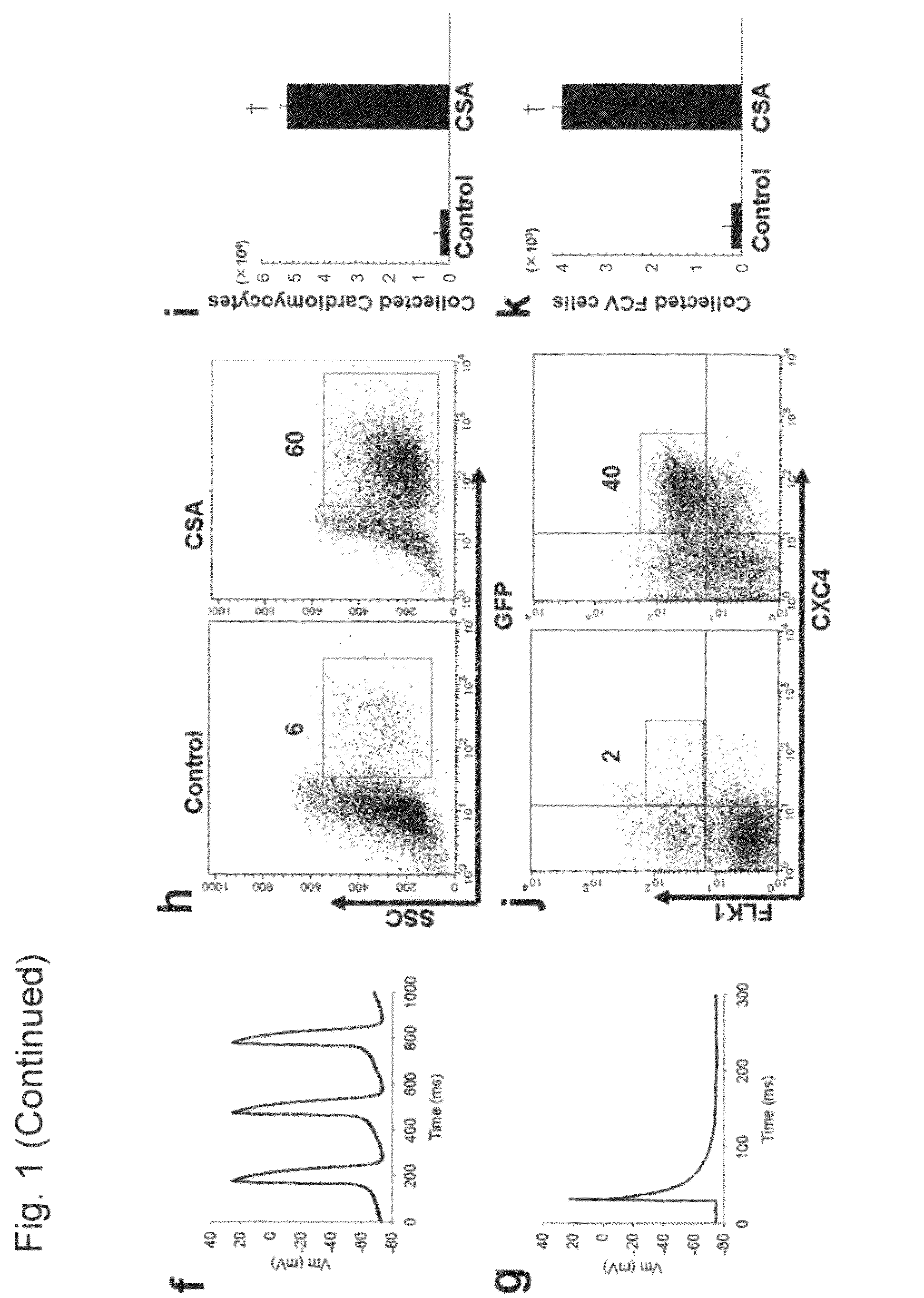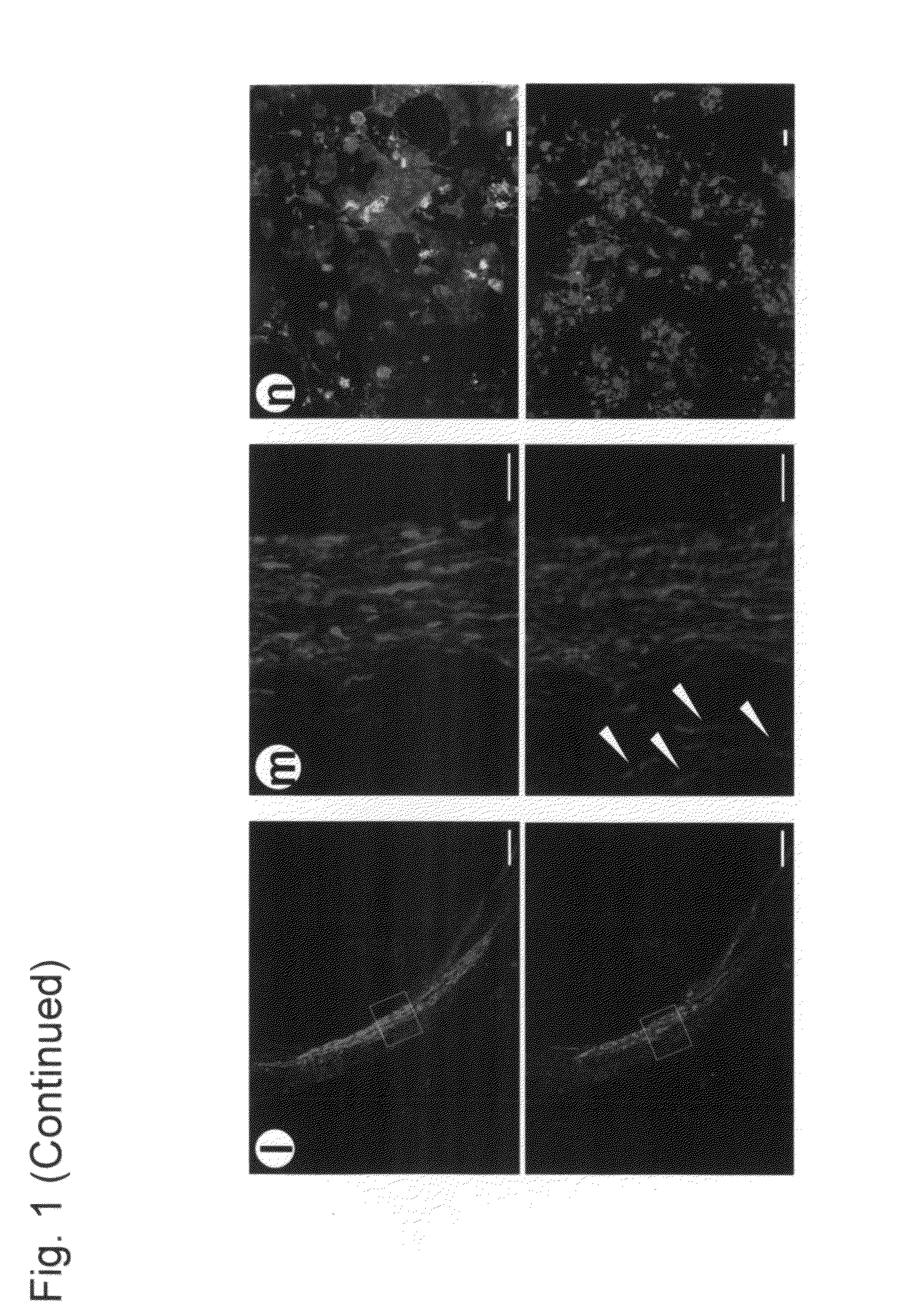Efficient production and use of highly cardiogenic progenitors and cardiomyocytes from embryonic and induced pluripotent stem cells
a high-cardiac progenitor, embryonic and induced pluripotent stem cell technology, applied in the direction of skeletal/connective tissue cells, instruments, drug compositions, etc., can solve the problems of ineffective progenitor, inability to establish model systems for cardiac differentiation, and inability to efficiently produce ips cell technologies
- Summary
- Abstract
- Description
- Claims
- Application Information
AI Technical Summary
Benefits of technology
Problems solved by technology
Method used
Image
Examples
example 1
Cardiogenic Effect of CSA on ES Cells
[0135]In our cardiomyocyte differentiation system, we can identify and purify cell populations at four sequential differentiation stages, that is, undifferentiated ES cells, Flk1+ mesoderm cells, FCV cardiac progenitor cells, and cardiomyocytes (FIG. 4) (Yamashita, J. et al. Nature 408, 92-96 (2000); Yamashita, J. K. et al. FASEB J. 19, 1534-1536 (2005)). When purified Flk1+ cells are cultured on OP9 stroma cells, self-beating cardiomyocytes appear by 4 days of culture (Flk-d4). When we added CSA to Flk1+ cells to confirm its in vitro effect on cardiomyocyte differentiation before using it in cell transplantation experiments, CSA (1-3 μg / mL) showed a striking effect to increase beating cells at Flk-d6 (experiment 1 in FIG. 4) (FIG. 1a). Addition of CSA induced approximately 13 times increase in cardiac troponin-T (cTnT)-positive cardiomyocyte appearance than control (FIG. 1b, c). CSA-induced cardiomyocytes showed distinct expression of cTnT (FIG....
example 2
Cardiogenic Effect of CSA on iPS Cells
[0138]We further examined the cardiogenic effect of CSA on iPS cells. Recently, we demonstrated that mouse iPS cells (Okita, K. et al., Nature 448, 313-317 (2007)) could give rise to cardiomyocytes using the identical differentiation method for mouse ES cells (Yamashita, J. K. et al. FASEB J. 19, 1534-1536 (2005); Narazaki, G, et al. Circulation 118, 498-506 (2008)). CSA treatment on purified iPS cell-derived Flk1+ cells markedly increased the cardiomyocyte appearance by approximately 12 times than control (FIGS. 2a, b). CSA treatment also drastically increased FCV cardiac progenitor population in iPS cells. The maximum percentage of FCV cells from iPS cell-derived Flk1+ cells was increased up to 28% by CSA. (FIG. 2c).
[0139]Next, we examined cardiomyocyte differentiation from human iPS cells (Nakagawa, M. et al. Nat. Biotechnol. 26, 101-106 (2008)). When human iPS cells were cultured on END-2 visceral endodermal stroma cells (Mummery, C. et al. ...
experimental procedures
for Examples 1 and 2
[0144]Antibodies
[0145]Monoclonal antibodies (MoAbs) for murine E-cadhein (ECCD2), murine Flk1 (AVAS12) were prepared and labeled in our laboratory as described previously (Yamashita, J. et al. Nature 408, 92-96 (2000); Yamashita, J. K. et al. FASEB J. 19, 1534-1536 (2005)). MoAb for cardiac troponin-T (cTnT) (1:2000) was purchased from NeoMarkers (Fremont, Calif.). For staining human iPS cells, MoAbs for cTnT (1:100) was from Santa Cruz Biotechnology (Santa Cruz, Calif.). MoAbs for murine α-actinin (1:800) was from Sigma (St Louis, Mo.). MoAb of PE-conjugated AVAS12 was purchased from eBioscience (San Diego, Calif.). MoAbs for mouse CD31 (for immunostaining, 1:200) and Biotinylated-CXCR4 was purchased from BD Pharmingen (San Diego, Calif.). Polyclonal rabbit antibody to GFP (1:500) was purchased from MBL (Nagoya, Japan).
[0146]Reagents
[0147]Cyclosporin-A (a gift from Novartis Pharma) was dissolved in Dimethyl sulfoxide (DMSO) (Nacalai Tesque, Kyoto Japan) at 30 mg...
PUM
| Property | Measurement | Unit |
|---|---|---|
| thickness | aaaaa | aaaaa |
| beating area | aaaaa | aaaaa |
| fluorescent intensity | aaaaa | aaaaa |
Abstract
Description
Claims
Application Information
 Login to View More
Login to View More - R&D
- Intellectual Property
- Life Sciences
- Materials
- Tech Scout
- Unparalleled Data Quality
- Higher Quality Content
- 60% Fewer Hallucinations
Browse by: Latest US Patents, China's latest patents, Technical Efficacy Thesaurus, Application Domain, Technology Topic, Popular Technical Reports.
© 2025 PatSnap. All rights reserved.Legal|Privacy policy|Modern Slavery Act Transparency Statement|Sitemap|About US| Contact US: help@patsnap.com



